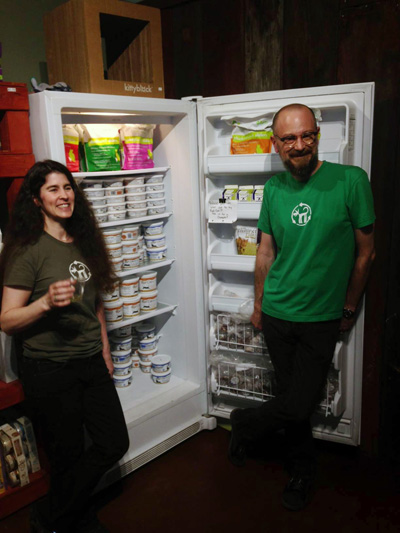This week we had to tell our customers about another voluntary recall of raw pet food. The Rad Cat Company was notified by the FDA and the Ohio Department of Agriculture after several tubs of multiple varieties of Rad Cat Raw Diet were purchased and tested. All samples tested negative for E. Coli and Salmonella but two tested positive for Listeria Monocytogenes.
by the FDA and the Ohio Department of Agriculture after several tubs of multiple varieties of Rad Cat Raw Diet were purchased and tested. All samples tested negative for E. Coli and Salmonella but two tested positive for Listeria Monocytogenes.
Outdoor cats likely encounter Listeria frequently, as Listeria is a common presence in nature, found widely in such places as water and soil, leafy vegetables and animal products. It could however be a danger to some animals who eat it, and especially to the people that might handle the food without washing their hands or the surfaces exposed to it after feeding it.
We believe Rad Cat when they say that their third party inspections have come back clean. We’ve been in their kitchens and have never seen a facility so tightly controlled for cleanliness and safety. Their sourcing is impeccable. They use High Pressure Pasteurization to kill any bacteria that might be found on the poultry products before they are processed into their formulas, and they test the finished product with a third party lab, doing a full aerobic plate count. They then hold the food for a time before shipping it and it is tested again before releasing it to the distributor. The temperature is controlled through every step of its journey and even tested here at the store upon receipt to ensure that it was maintained as it  traveled to us. More details here. If only our human foods were handled and controlled for safety as strictly as the foods made at Rad Cat! We feed it with confidence to Otis, our senior cat. If I were pressed to name my favorite of the more than 4,500 items we carry, Rad Cat would be in my top two.
traveled to us. More details here. If only our human foods were handled and controlled for safety as strictly as the foods made at Rad Cat! We feed it with confidence to Otis, our senior cat. If I were pressed to name my favorite of the more than 4,500 items we carry, Rad Cat would be in my top two.
It might be an opportune time to mention our frustration with the disparity between how the FDA treats raw foods vs. how they treat other pet foods like kibble.
Raw food is under intense scrutiny, but the facts point to a significant lack of scrutiny towards kibble based foods, despite the fact that in past years dry food recalls have far outpaced raw food recalls, and the most significant recalls, complaints of illnesses, and death have all resulted from contaminated dry pet foods.
A Few Examples:
Over 100 dogs died in 2005 from aflatoxin Poisoning (a very dangerous, carcinogenic grain mold, most commonly found in corn but is also possible in ingredients like peas). Surveys done in 2016 show that aflatoxin has been found in higher amounts than ever (A total of 387 corn samples and 79 distiller’s dried grains with solubles (DDGS) samples from across the U.S. were tested. Results revealed that 90 percent of corn samples and 100 percent of DDGS samples were contaminated by at least one mycotoxin, and 96 percent of the DDGS samples contained more than one), yet there have been no aflatoxin recalls since 2013. We must assume that FDA must not be testing regularly for aflatoxins.
Judging from the number of recalls for Salmonella in raw foods, it

Photo Designed by Freepik
would lead you to believe that there is a significant risk of salmonella in raw foods, and in fact the FDA even issued a warning about the risks of salmonella in raw pet food. However, from 2010 – 2015, 78 types of kibble pet food were recalled due to salmonella contamination, vs. 27 for raw foods. What this number doesn’t even capture is the sheer quantity of kibble that was recalled during this time, vs. raw foods with single lot numbers/single flavors. In the 2013 the Natura recall was massive – millions of pounds – and included all of its many formulas including treats (“All Lot Codes, All UPC’s, All package sizes, All expiration dates”). The recall for salmonella in the Diamond foods that were produced at their South Carolina Plant in 2012 resulted in the recall of all of their brands and stopped ALL production for a time. The Taste of the Wild part of this recall alone resulted in over 10 million pounds of food being pulled from store shelves.
No Warnings About Dry Foods
Neither the FDA or the AVMA has ever issued a formal warning about the risk of salmonella in all pet foods. In fact, the same week that the AVMA issued a warning to consumers about the risk of salmonella in raw pet foods, there were (according to the CDC) a total of 49 individuals (47 individuals in 20 states and two individuals in Canada) infected with the outbreak strain of Salmonella Infantis related to this salmonella recall at Diamond foods. This included at least 10 people hospitalized. The FDA has announced regular testing for raw foods, but not for dry pet foods. In fact, they have not appeared to test any dry pet foods recently, as there have been no salmonella recalls for dry pet food since 2015, which is in stark contrast to many years before this time.
A class action suit was dropped against Beneful in 2016 stating, “The Court rejects Plaintiffs’ position that a reasonable jury could find Beneful unsafe based on the mere fact that 1,400 dogs ate Beneful and got sick or died thereafter. This is insufficient evidence of causation.” So many complaints of illness and death had been reported by Beneful consumers to the FDA that they did do some testing. Some samples came back positive for Melamine (the same thing found in that terrible 2007 recall that resulted in hundreds, possibly thousands of deaths), and some samples came back positive for ethoxyquin, a euthanasia drug so recently implicated in that Evanger’s recall that killed a dog. Beneful also refused access to the FDA to records and didn’t allow them to photograph their manufacturing plant. Yet the FDA did not issue any warning nor was there any sort of a recall. Can you imagine a brand of raw food with 1,400 allegations of sickness and deaths without repercussions?
We certainly do not mean to minimize the risks of any pathogen in any form of pet food, especially to the humans that handle these foods and are not as well equipped as their carnivorous pets to stay healthy when exposed. We just wish the FDA, AVMA, and Big Pet Food would hold all pet foods to the same standards of safety.

